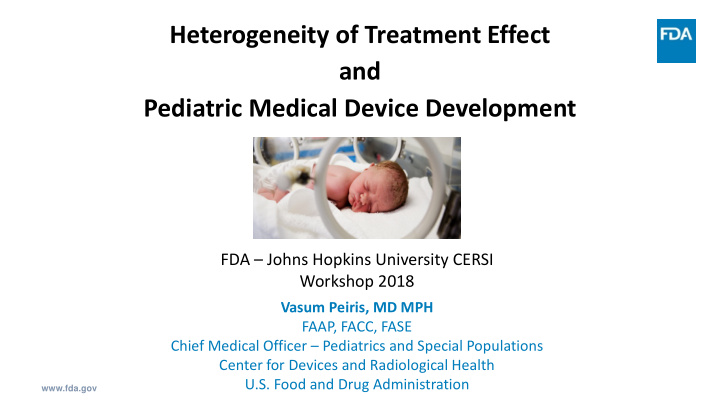



Heterogeneity of Treatment Effect and Pediatric Medical Device Development FDA – Johns Hopkins University CERSI Workshop 2018 Vasum Peiris, MD MPH FAAP, FACC, FASE Chief Medical Officer – Pediatrics and Special Populations Center for Devices and Radiological Health U.S. Food and Drug Administration www.fda.gov
Challenge Question: How long can a neonate tolerate a heart rate of 220 beats per minute? www.fda.gov
FDA CDRH - Pediatrics and Special Populations Pediatric Age Groups Birth – 28 days 29 days - < 2yrs 2yrs - < 12yrs 12yrs - < 22yrs www.fda.gov
www.fda.gov
A world where it can be made for children first is here… www.fda.gov
Adult Devices Increasing Faster than Pediatric y = 3.8x + 13.1 # of Approved Devices R² = 0.67 50 p=0.004 40 30 20 y = 0.96x + 5.1 R² = 0.41 10 p=0.046 0 2008 2009 2010 2011 2012 2013 2014 2015 2016 2017 n=29 n=31 n=20 n=41 n=52 n=39 n=37 n=61 n=71 n=66 Fiscal Year Approved PMA and HDE Devices (Pediatric) Approved PMA and HDE Devices (Non-Pediatric) Linear (Approved PMA and HDE Devices (Pediatric)) Linear (Approved PMA and HDE Devices (Non-Pediatric)) Upward trajectory in the total number of PMA and HDE applications Adult approvals significantly greater than pediatric approvals www.fda.gov
Little Change in Percentage of Pediatric Approvals 100% % of Approved Devices with a y = -0.0032x + 6.775 80% R² = 0.0137 Pediatric Indication p=0.8 60% 40% 20% 0% 2008 2009 2010 2011 2012 2013 2014 2015 2016 2017 Fiscal Year Percentage of Pediatric Indications Linear (Percentage of Pediatric Indications) Novel devices are not being developed for children at a similar rate as for adults www.fda.gov
Steps Toward a Contemporary System for Adults and Children If we can foster a system that supports technology innovation that serves the complex needs of children, then we will accelerate device development for everyone www.fda.gov
Thank You www.fda.gov
Thank You www.fda.gov
Recommend
More recommend